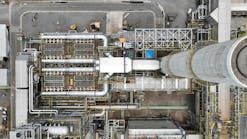Start-up continues at Abreu e Lima refinery
Petroleo Brasileiro SA (Petrobras) has initiated the start-up of furnaces in the atmospheric distillation unit at its Abreu e Lima refinery (Rnest) at the port of Suape, near Recife, the capital of Pernambuco state.
The unit’s two furnaces officially were entered into operation on Dec. 3, Petrobras said.
The firing-up of the furnaces follows the introduction into the unit of natural gas on Nov. 19 and first crude on Nov. 24, the company said.
Petrobras began initial start-up activities at the refinery—which is to be commissioned in two 115,000-b/d phases—on Nov. 18 following official approval from Brazil’s National Petroleum Agency (ANP) (OGJ Online, Nov. 19, 2014).
While ANP’s mid-November approval authorized Petrobras to begin operation of Rnest’s atmospheric distillation, caustic treatment, and naphtha hydrotreating units, the agency has now stipulated that the distillation unit is limited to a crude processing capacity of 74,000-b/d, or about 64% of its 115,000-b/d nominal capacity, according to a Dec. 4 notice published in Brazil’s Official Gazette (DOU).
The distillation unit may ramp up to its full nameplate capacity only after an associated emissions abatement unit at the refinery is in “perfect working order” to conform with the existing operating license issued to Petrobras by Pernambuco’s State Agency for the Environment, ANP said.
Rnest contains two proprietary SNOX plants from Haldor Topsoe AS SNOX plants that each treat up to 650,000 cu m of flue gas and produce as much as 750,000 tonnes/day of sulphuric acid, according to a November 2011 release from Topsoe.
In addition to the atmospheric distillation unit and a variety of storage tanks, the Dec. 4 DOU notice also authorizes Petrobras to proceed with commissioning of the following units:
• A 75,000-b/d delayed coker.
• A 7,000-b/d caustic treatment unit.
• An 82,000-b/d diesel hydrotreater.
• A 19,000-b/d naphtha hydrotreater.
• A 3 million-cu m/day hydrogen generation unit.
• A 3,600-cu m/day acidic water treatment unit.
Once fully operational, Rnest will have the capacity to process 230,000 b/d of 16° API crude for the production of mainly low-sulfur diesel, but also naphtha, petroleum coke, LPG, and heavy coker gas oil.
Rnest’s second 115,000-b/d phase is scheduled to be commissioned in 2015 (OGJ Online, Nov. 6, 2014).
